News Letter
Sign Up & get 33% off your first order
Enter your preferred name & e-mail to subscribe

A coaxial solenoid valve can be electro mechanically or coaxial pneumatically controlled valve i.e. is directly controlled by either an electric current or by a pneumatic (pressurised gas) supply to produce a lateral mechanical function. In the case of a two port coaxial valve the flow is switched on or off, in the case of a three port coaxial valve, the out flow is switched between two outlet ports or multiple coaxial valves or multifunction valves can be placed together on a manifold system.
Coaxial valves are most commonly used for precise control liquids and gases, whose task is to shut off, release, dose, distribute or mix gas or liquid media.
Coaxial valves offer fast and safe reliable switching, very high liability, excellent medium compatibility of the materials of construction, low power or air consumption, compact and high flow design for many vacuum, inert, aggressive, contaminated and glutinous liquids. The coax valve design allows for vastly improved linear straight-line flow along a tube and does not suffer the same restrictions normally found with a basic solenoid operated valve that suffers from an arduous flow path.
Coaxial valve construction consists of a laterally mounted tube usually mounted in a Brass or Stainless Steel housing allowing for lateral tube movement from (to open allowing media flow) or against (to close preventing media flow) a range of static elastomer rubber NBR, FKM, EPDM or PTFE seals.
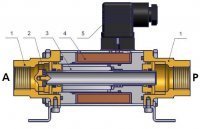

Based on a coaxial valve with 2 ports. If the coaxial valve is closed without actuation (without electrical power or air supply), then the 2 ports are isolated and media cannot flow; when the coaxial valve is actuated then the media may flow between the ports, this function is deemed as normally closed or fail-safe closed.
If the coaxial valve is open without actuation (without electrical power or air supply), then the 2 ports are open and media can flow; when the coaxial valve is actuated then the media cannot flow between the ports and they are isolated, this function is deemed as normally open or fail-safe open.
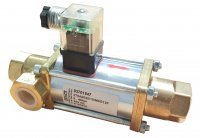 There are also 3-way and manifold design options also found. A 3-way coaxial valve has 3 ports; it connects one port to either of the other two
There are also 3-way and manifold design options also found. A 3-way coaxial valve has 3 ports; it connects one port to either of the other two 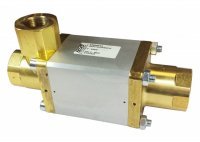 ports (typically a supply port to an exhaust or diverting port). The picture on the left shows a 3 way solenoid operated coaxial valve, the picture on the right shows an externally compressed air operated 3 way coaxial valve.
ports (typically a supply port to an exhaust or diverting port). The picture on the left shows a 3 way solenoid operated coaxial valve, the picture on the right shows an externally compressed air operated 3 way coaxial valve.
Here flow is diverted to the third port (port R exhaust port), for example typically flow is controlled from port P (inlet) to port A outlet and then from port A outlet back thought to port R (exhaust), much like a 3/2 solenoid valve for cylinder or actuator control, however coaxial valves can control much higher flow, pressure and a broader range of sizes and media. Unlike standard solenoid valves coaxial valves can control flow in both directions, typically in reverse will be reduced pressure range of about 16 bar.
Coaxial valves are usually available in a range of port sizes typically in threaded BSP or NPT in 1/8", 1/4", 3/8", 1/2", 3/4", 1", 11/4", 11/2" and 2" thread or more with range of flange PN16, PN25, PN40, PN100 options. The port size generally does not affect the flow rate unless the port is smaller than the internal tube diameter sometimes referred to as the orifice size.
There are a range of internal tube diameter sizes available for coaxial valves (both solenoid and pneumatically operated) typically 2.0mm, 3.0mm, 4.0mm, 5.0mm, 6.0mm,10.0mm, 15.0mm, 20.0mm, 25.0mm, 32.0mm, 40.0mm and 50mm. The tube internal diameter typically determines the flow rate (excepting that the port size nominal bore is of equal size or more) offering a specific flow coefficient according to tube diameter. For example in the case of a 2-way coaxial valve typical Kv flow coefficients in litres per minute would be:
|
Tube Diameter (mm) |
Flow Litres / minute |
| 10 | 51 |
| 15 | 91 |
| 20 | 145 |
| 25 | 205 |
| 32 | 333 |
| 40 | 637 |
| 50 | 787 |
In practical terms Kv flow coefficient is the amount of water at 20°C that would flow with a pressure drop of 1 kilogram per centimetre across the valve. i.e. the pressure difference between inlet and out let pressure). Coaxial valve are available in 2/2 way (2 ports inlet and outlet) and 2 positions (fail safe open or fail safe closed) and 3/2 way (3 ports for example 1 inlet and 2 outlets for diverting flow) with 2 positions (fail safe open or fail safe closed against the second of third port). Due to the compact nature of coaxial valves they can easily be mounted onto a manifold system with either common inlet or outlet.
The valve body must be compatible with the media; common materials are steel, brass, AISI304 or AISI316 stainless steel. The seals must also be compatible with the fluid. To simplify the sealing issues, the valve body and tube are exposed to the media, so they must be compatible as well. The requirement presents some special but easily resolvable problems. The internal tube is typically 316 stainless steel that has a great chemical resistance, however the valve body will so need to be compatible material. The surrounding mechanical parts attached to the tube required for operation and the springs are sealed and are not exposed to the media, unlike a standard solenoid valve where all internal parts must be considered.
Many variations are possible from the basic 2/2 way (2 ports (inlet/outlet and 2 positions open/closed). The coaxial valve tube position can be mechanically checked by installing a position switch into the body that can be activated by the lateral movement of the internal tube to confirm the coaxial valve open and or closed position for remote signal confirmation by an operator. The coaxial valve tube can also be mechanically moved laterally by a simple addition of a mechanical lever or cam thus providing a manual over ride facility for engineers during installation or power failures.
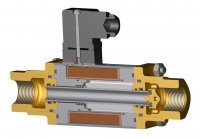 |
Coaxial solenoid and externally controlled valves are ideal for controlling vacuum, gas, liquids, thick glutinous viscous liquids including abrasive, contaminated and media steam and very aggressive media such as strong alkali's and acids. The Coaxial valve design allows for high flow, high pressure and bi-directional ON/OFF control. With such compact strong and high reliability features ensuring a long maintenance free life, great sealing characteristics. |
|
 |
Coaxial Solenoid Valves are available in 2/2 and 3/2 way configurations with port options in BSP, NPT or flanged ends. Pressure ranges from Vacuum to over 160 Bar Body Materials available in Brass, AISI304 and AISI316L Stainless Steel. Port Sizes available from 1/4 though to 2". |
|
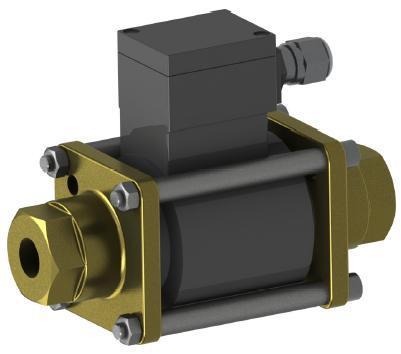 |
ATEX EExemIIT4 2/2 way and 3/2 way Coaxial Solenoid Valves for Hazardous Area use are also available in normally open and normally closed configurations with threaded BSP, NPT and flanged port options. Pressure ranges from Vacuum to 20 Bar Body Materials available in Brass, AISI304 and AISI316 Stainless Steel. Explosion Proof protection II 2G Ex em II T4, II 2D td A21 IP65 T130C Available voltages 24vDC and 230vAC. |
|
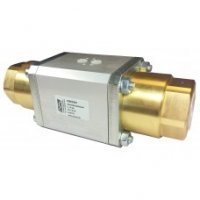 |
Coaxial Externally Controlled (Air Pilot) Valves are also available in 2/2 and 3/2 way configurations with threaded port options in BSP, NPT or flanged ends. Pressure ranges from Vacuum to over 160 Bar Body Materials available in Brass, AISI304 and AISI316L Stainless Steel. Port Sizes available from 1/4 though to 2" |
|
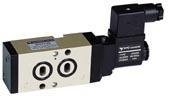 |
Namur Mount Air Pilot Valves with Safe Area IP65 or ATEX Hazardous Area EexmIIT4 coils. In both Spring return and Double Acting configurations. Fit directly onto the pneumatically operated coaxial valve without the need of connectors, fittings and additional pipe work. |
 |
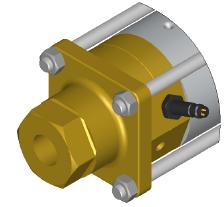 |
Position Indication switches for coaxial valves. This allow for remote confirmation to know when the coaxial valve is physically in the open position or open and closed positions. E1 open Position switch E2 both Open position switch and closed position switch. |
|
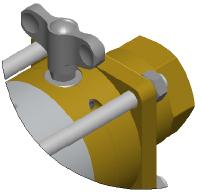 |
Manual Over Ride to allows manual control over ride of the coaxial valve into the open position. This is an ideal option for maintenance and pre installation checks when no power or air supply is available. Also very helpful to compensate for power and compressor failures when the coaxial valve needs to be in the open position to maintain production line productivity. |
|
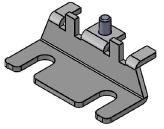 |
Mounting brackets are available for all coaxial valves. These mounting brackets are normally mounted opposite the coil (under the valve) however these can be mounted either side of the coil. The coil can also be mounted in any of four positions around the valve by request before production, which is very useful option when using 3/2 way coaxial valves for specific applications and pipe work design. |
|
Typical coax valve options include ATEX Protection, Position Switches, Manual Over Ride Facility, High Temperature, Cryogenic and corrosive Media or environments, Oil and Grease Free for Oxygen use, Steel construction, Mounting Brackets and coil power levels and coil location relative to ports and mounting bracket location. Other custom made Coaxial valve solutions and manifold systems are also readily available to meet customer specifications.
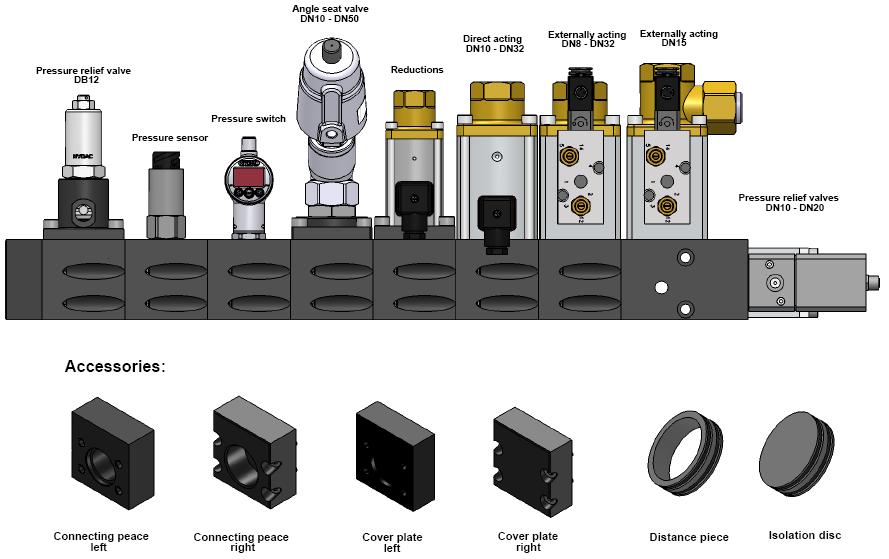
A catalouge of articles covering all aspects of solenoid valves
Enter your preferred name & e-mail to subscribe